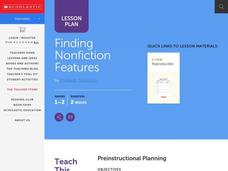Curated OER
Creative Problem Solving: Using the 5 W's (Who, What, Where, When, Why)
Third graders assimilate the use of the 5 W's (Who, What, Where, When, Why) when solving problems that are presented in literature and in real life situations. They use common fairy tales to solve problems that might arise at home or...
Curated OER
Frog Principal Lesson Plan
Students read the fractured fairy tale, The Frog Principal by Stephanie Calmenson and compare it to the original version in order to gain deeper understanding of the fairy tale genre. In this fairy tale lesson, students identify and...
Curated OER
Math on a Roll
Students practice various math skills using a polyhedral die. For this dice game lesson, students practice multiplication, addition, place value, and money using games. Standard dice may be used instead of a polyhedral die with...
Curated OER
Sowing Seeds
Students observe earth science by participating in a planting activity. In this seeds lesson, students identify the process for seeds to transform into plants which eventually produce food. Students sow seeds in the ground and eventually...
Curated OER
Seed to Plant
Students understand the stages of a plants life. In this stages of plant development activity, students read about bean plants and grow their own. Students record growth and photograph changes in their plants. Students label the parts of...
Curated OER
Finding Nonfiction Features
Students review the differences between a fiction and non-fiction book. In groups, they use different non-fiction books to identify the eleven features that distinguish it from a fiction book. To end the lesson, they create a chart...
Curated OER
Over and Under Estimation
First graders distinguish between an over-estimate and an under-estimate. They estimate the number of beans that can be held in a hand, organize data and actual findings.
Other popular searches
- <I>jack and the Beanstalk</i>
- Jack and the Beanstalk Story
- Sequence Jack and Beanstalk
- Powerpoint Jack Beanstalk
- Jack and Beanstalk Stories
- Jack and Beanstalk Craft
- Jack Beanstalk Script
- Jack and Beanstalk Puppets
- Jack and the Beanstalk Art
- Jack Beanstalk Story Map








